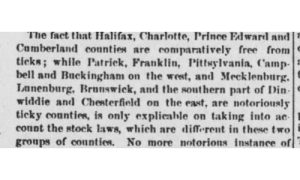Last week, we learned about the drought and resulting starvation in Patrick County in 1881-1882. The following years did not get any better for the residents; they were plagued with fires, smallpox, and an abnormal tick infestation.
 In April of 1889, a devastating forest fire, extending from Patrick Springs to Critz, cut a path of destruction ten miles long and six miles wide. A dispatch from Critz’s Depot, on the Danville and Western Railroad, gave a graphic account of the terrible fire… “A fire commenced Friday afternoon and burned until heavy rain on Sunday night aided the men in stopping the fire. A slight rain Friday impeded the flames temporarily, but they resumed on Saturday and raged with increased vigor. The flames swept through Wild Cat Hollow like a tornado, preceded by sounds like rolling thunder, and dashed up the mountain sides. Houses, fences, barns, stables and granaries were swept away like tinder boxes.”
In April of 1889, a devastating forest fire, extending from Patrick Springs to Critz, cut a path of destruction ten miles long and six miles wide. A dispatch from Critz’s Depot, on the Danville and Western Railroad, gave a graphic account of the terrible fire… “A fire commenced Friday afternoon and burned until heavy rain on Sunday night aided the men in stopping the fire. A slight rain Friday impeded the flames temporarily, but they resumed on Saturday and raged with increased vigor. The flames swept through Wild Cat Hollow like a tornado, preceded by sounds like rolling thunder, and dashed up the mountain sides. Houses, fences, barns, stables and granaries were swept away like tinder boxes.”
According to the Page Courier, Volume 22, Number 52, 18 April 1889, sixty-five head of cattle, at least ten horses, and over two hundred hogs were burned to death. One man was killed and four people were missing after the fire. Over one hundred families were left homeless, with only the clothes on their backs.
Incredibly, while this forest fire was going on, Patrick County was under a quarantine for smallpox! The Fairfax Herald, Volume 7, Number 47, 19 April 1889, reported that smallpox was raging in Patrick County and three deaths occurred in the first two weeks of April. Twenty people in Stella, Mayo Forge, and Liberty were infected and isolated in pest houses.
A pest house is a “house of pestilence” where unfortunate souls are quarantined until they get well or pass away. At the Old City Cemetery in Lynchburg, you can visit Dr. John J. Terrell’s pest house where he cared for soldiers suffering from smallpox. Dr. Terrell had the interior walls of the pest house painted black because of the soldiers’ eyes sensitivity to light and he had dry white sand spread on the floor to absorb the offensive odors.
According to the Fairfax Herald, Dr. B. B. James, city physician of Danville, and Dr. J. R. Anderson, of Martinsville Cared for the infected individuals in Patrick County. The towns of Stuart and Martinsville established quarantines against Stella, Mayo Forge, and Liberty, and Mayor Harry Wooding, of Danville, issued a proclamation prohibiting any person or persons coming from Henry county west of Martinsville contiguous to the Danville and Western railroad, or from Patrick county contiguous to the Danville and Western railroad from entering Danville until further notice. According to a telegraph dispatch received at the Critz’s Depot, the disease had been brought to Patrick county by a woman from Roanoke.
As if forest fires and smallpox were not enough, seven years later, Patrick County and several other Virginia counties were overrun with ticks. The U.S. Department of Agriculture investigated and discovered that counties that had “no fence” laws for cattle were infested with ticks, while counties that enforced “fence laws” reported having few or no ticks. Once again, Patrick County was under a quarantine, this time for ticks. The quarantine was released once the inspector from the Department of Agriculture inspected the cattle and found them parasite-free.
There are so many lessons to be learned from those that came before us; they endured starvation, fires, smallpox, and many more threats and plagues, but every time, they got right back up and started all over again.
Woody may be reached at rockcastlecreek1@gmail.com or 276-692-9626.




